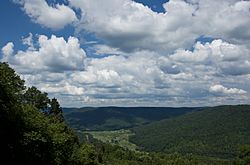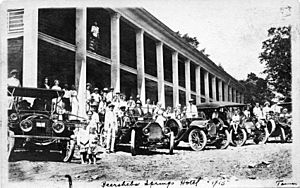Beersheba Springs, Tennessee facts for kids
Quick facts for kids
Beersheba Springs, Tennessee
|
|
|---|---|

A view of Tarlton Valley from Beersheba Springs
|
|

Location of Beersheba Springs in Grundy County, Tennessee.
|
|
| Country | United States |
| State | Tennessee |
| County | Grundy |
| Incorporated | 1835 |
| Area | |
| • Total | 4.80 sq mi (12.43 km2) |
| • Land | 4.80 sq mi (12.43 km2) |
| • Water | 0.00 sq mi (0.00 km2) |
| Elevation | 1,850 ft (560 m) |
| Population
(2020)
|
|
| • Total | 434 |
| • Density | 90.44/sq mi (34.92/km2) |
| Time zone | UTC-6 (Central (CST)) |
| • Summer (DST) | UTC-5 (CDT) |
| ZIP code |
37305
|
| Area code(s) | 931 |
| FIPS code | 47-04240 |
| GNIS feature ID | 1305073 |
Beersheba Springs /ˈbɜːrʃəbə/ is a town in Grundy County, Tennessee, United States, in the south central part of the state. The population was 477 at the 2010 census. A prominent resort town in the 19th century, Beersheba Springs was developed in 1854 by retired wealthy slave trader, John Armfield, who bought property in the area. It became a destination for wealthy guests from Nashville and other cities.
Tennessee author Mary Noailles Murfree later regularly stayed at the complex in the summer. The town now serves as a major summer meeting center for the Tennessee United Methodist Church.
Contents
History
In 1833 Beersheba Porter Cain discovered a chalybeate spring. The spring and surrounding area, located above Collins River Valley, were incorporated in 1839. Upon its incorporation, Beersheba Springs was developed as a summer rural resort with a small hotel and log cabins. It was notable for its mineral waters, which were thought to have health-giving properties. The resort would be popular with stagecoach traffic that would travel between Chattanooga and McMinnville.
Eventually Louisiana planters also moved into the area, leaving behind the notoriously hot and humid summers of their home state. Beersheba Springs served as the summer home for Tennessee authorMary Noailles Murfree.
Beersheba Springs resort
In 1854 Colonel John Armfield, a planter and former slave trader based in Alexandria, Virginia and New Orleans, Louisiana, acquired the property. He transported upwards of 100 slaves to Beersheba Springs to develop the property as a resort destination with a new luxury hotel, cabins and grounds to accommodate 400 guests. The resort also featured laundry facilities, ice houses, billiard rooms, and bowling alleys. French chefs were brought in to serve guests, as were musical acts from New Orleans.
Enslaved African Americans built a wooden observatory at the front of the hotel. From the observatory, white guests could watch Confederate and Union armies battle during the Civil War. Eventually the threat of war, raids, and plundering caused a decline in visitors to Beersheba Springs. It was sold to Northern investors.
The resort re-opened in the 1870s during the Reconstruction era, but it never returned to its former glory. In 1940, the Methodist Church purchased the resort and re-opened it for assembly and summer camps.
Architecturally the resort remains largely unchanged, although in the late 20th century, parts of the hotel were "modernized" or restored. The camp now serves as the site of the annual Beersheba Springs Arts and Craft Fair. It is still a site for Methodist Church assemblies and summer camps.
In 1980 the resort area was placed on the National Register of Historic Places.
Geography
Beersheba Springs is located at 35°28′2″N 85°40′18″W / 35.46722°N 85.67167°W (35.467209, -85.671700). According to the United States Census Bureau, the town has a total area of 4.9 square miles (13 km2), all land.
Demographics
| Historical population | |||
|---|---|---|---|
| Census | Pop. | %± | |
| 1880 | 138 | — | |
| 1960 | 577 | — | |
| 1970 | 560 | −2.9% | |
| 1980 | 643 | 14.8% | |
| 1990 | 596 | −7.3% | |
| 2000 | 553 | −7.2% | |
| 2010 | 477 | −13.7% | |
| 2020 | 434 | −9.0% | |
| Sources: | |||
2020 census
| Race | Number | Percentage |
|---|---|---|
| White (non-Hispanic) | 397 | 91.47% |
| Black or African American (non-Hispanic) | 1 | 0.23% |
| Native American | 2 | 0.46% |
| Other/Mixed | 27 | 6.22% |
| Hispanic or Latino | 7 | 1.61% |
As of the 2020 United States census, there were 434 people, 198 households, and 144 families residing in the town.
Beersheba Springs today
The former resort serves as a retreat for the Tennessee branch of the United Methodist Church and the Arts and Craft festival. The Old Brown Museum, a former country store, now serves as a community museum documenting the history of Beersheba Springs. The town, with a population of 477, is the home to seven churches.
See also
 In Spanish: Beersheba Springs para niños
In Spanish: Beersheba Springs para niños


